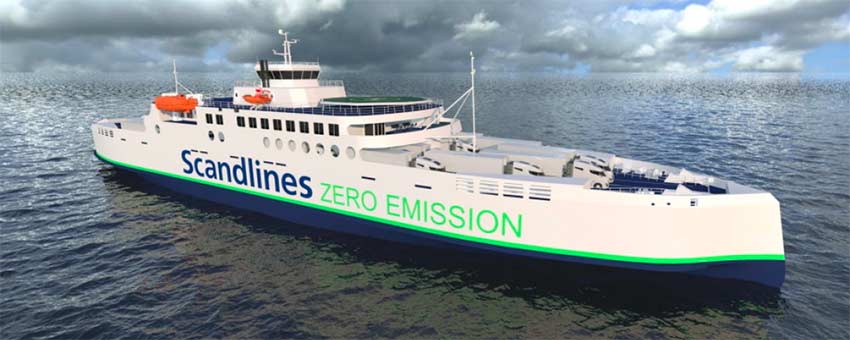Danish ferry company Scandlines, which operates two services between Denmark and Germany, converted a ferry to hybrid propulsion in 2013 and has since worked on ways to reduce emissions and to meet its target of becoming emission free by 2040. A ro-pax ferry currently on order at the Cemre Shipyard in Turkey will take the company further forward on that path.
“We will continue to invest in green initiatives and strengthen our competitiveness by developing our business to cater to the needs of all customers. We have therefore set out to realise our zero-emission vision by 2040, and we aim to reach scope 1 and 2 zero direct emission operations on the Puttgarden-Rødby route by 2030 as an important first step on this journey,” CEO Carsten Nordland notes in the company’s 2021 annual report.
The new vessel has been designed jointly by the in-house technical team of Scandlines and LMG Marin, the Norwegian consultancy, which has an extensive reference list of electric- and hybrid-powered, double-ended ferries.
The keel of the hybrid ro-pax ferry that can make the 11-mile crossing between Rødby Havn in Denmark and Puttgarden in Germany entirely on battery power was laid at the end of August 2022.
Called PR24 at this stage, with the letters derived from the names of the ports the vessel will serve and the numbers from its anticipated year of service entry, the ferry will be emission free when using batteries. The crossing time will be 70 minutes in this mode, states Anette Ustrup Svendsen, head of Corporate Communications, at Scandlines.
The vessel, which will be 147.4m long, 25.4m wide and 5.3m design draft, will make the crossing at 10knots in battery mode. However, the vessel can also be operated as a hybrid ferry, which will increase the speed of the ferry to 16knots and reduce the crossing time to 45 minutes by using MTU’s 1,560kW gensets. Cemre Shipyard said in a statement that provision is made in the design to allow the ship to use methanol as fuel later in its life.
This means that the new ferry can also be used as backup vessel for one of the four double-ended ferries that are currently operating the Puttgarden-Rødby route. “Our PR24 has a modular design, so we can increase the number of passengers, if the need arises. Right now, we concentrate on our PR24 and don’t have any actual plans of building more ferries,” Svendsen notes. The ship will be able to carry 140 passengers on delivery.
A key element in the concept is the battery pack system, which will be supplied by Leclanché. This will be a lithium-ion G-NMC battery system with a capacity of 10MWh with a maximum voltage of 864volts and the supplier will guarantee it for 10 years. The battery energy storage system (BESS) uses a highly redundant architecture with 48 battery strings distributed across eight switchboards. Delivery of the system will begin in January 2023, Svendsen continues.
The BESS can be recharged in just 17 minutes by using a 50kV/25MW power cable in Rødby Havn, which was installed in 2019. However, as this does not currently extend to the berth that the vessel will use, work will start in the spring of 2023 to extend it and to build a transformer and charging station as well.
Norway’s Kongsberg Maritime will supply the ship’s Azipull thruster. “The thruster will be delivered with controllable pitch propellers, in an L-drive configuration with an integrated permanent magnet drive motor. This increases overall energy efficiency while reducing noise and vibrations, as well as reducing the physical footprint of the thruster system compared to previous deliveries,” according to Kongsberg.
Kongsberg’s Mcon propulsion and thruster control system will also be fitted on the vessel and this will allow the operator to check e.g. magnitude and direction of thrust and the condition of the equipment at a glance. The company has a long track record of cooperation with Scandlines as a main propulsion supplier.
The vessel will have capacity for a total of 66 freight units – equal to about 1,200-lane-metres – that will be carried on two decks. This means that a berth in both ports that the vessel will serve have to be rebuilt to allow handling of loading and discharging on two levels. Freight is very much in the focus of the vessel: it will increase freight capacity on the Puttgarden-Rødby Havn route by 23%.
Scandlines has decided to employ ReFlow, a Danish tech start-up, to produce a detailed life-cycle digital model of the vessel that will represent its life span from construction to the time when it will be taken out of service.
“The model will show the environmental impact of the ferry, not only in its use but also from its construction at Cemre Shipyard along with the installed equipment. The digital ‘climate twin’ will make it possible for Scandlines to run simulations on the use of new green technology on the ferry, something that is nearly impossible today,” states ReFlow.
The new vessel will make its debut in 2024 and will replace two old vessels in Scandlines’ service. The 1986-built, 86m Holger Danske, which was designed for the 20-minute crossing between Helsingor in Denmark and Helsingborg in Sweden, was taken out of service last year. Scandlines no longer operates this service
The much larger 152m Kronprins Frederi was built in 1981 for a domestic service between Nyborg and Korsor and is currently used as a freight only ferry. It will be phased out when the new ship enters service.
Scandlines has six hybrid ferries in service at the moment. The two largest units in the company’s fleet, the 169.5m-long Berlin and Copenhagen, were each fitted with a Norsepower rotor sail in 2020 and 2022, respectively.




